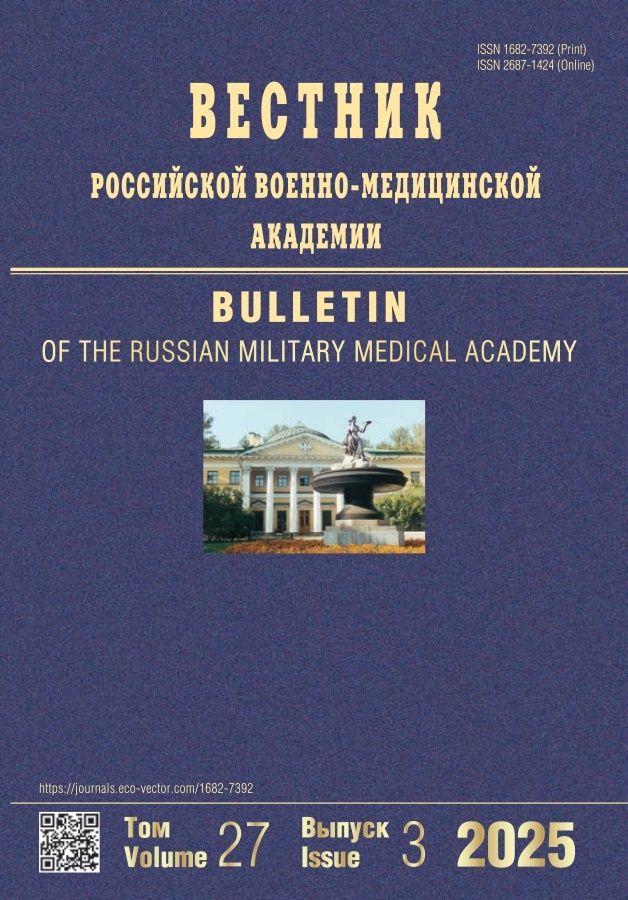Нейронавигационное ассистирование. Снижение лучевой нагрузки при операциях на позвоночнике у пострадавших с тяжелой сочетанной травмой
- Авторы: Бадалов В.И.1, Спицын М.И.1, Коростелев К.Е.1, Ярмошук Р.В.1, Родионова А.А.1
-
Учреждения:
- Военно-медицинская академия им. С.М. Кирова
- Выпуск: Том 22, № 2 (2020)
- Страницы: 59-65
- Раздел: Статьи
- URL: https://journals.rcsi.science/1682-7392/article/view/50047
- DOI: https://doi.org/10.17816/brmma50047
- ID: 50047
Цитировать
Полный текст
Аннотация
Представлены результаты исследования интраоперационного рентгеновского облучения пострадавших двух массивов: основного массива с использованием нейронавигации и контрольной группы, где применялась стандартная 2D-флюороскопия. Также была оценена лучевая нагрузка на оперирующего хирурга и вспомогательный персонал операционной. Интраоперационная визуализация осуществлялась с помощью навигационной стойки«iNtellect ENT Navigation» компании «Stryker» (Соединенные Штаты Америки) второго поколения для пострадавших основного массива и электронно-оптического преобразователя компании «Ziehm Vision RFD» (Германия) для пострадавших контрольной группы. Вариант визуализации с использованием электронно-оптического преобразователя особенно важен при минимально-инвазивных процедурах, где инструментализация проводится чрескожно без прямого анатомического контроля в отличие от открытых процедур или работы с искаженными анатомическими структурами при травмах. Бипланарная рентгеноскопия была одной из первых интраоперационных методик визуализации в режиме реального времени и остается одной из ведущих технологий в ортопедической и спинальной хирургии. Однако радиационное облучение от интраоперационной флюороскопии остается серьезной проблемой для пациентов, хирургов и вспомогательного персонала операционной. Отрицательное воздействие ионизирующего излучения приводит к повреждению клеток через индукцию дезоксирибонуклеиновой кислоты и высвобождению активных форм кислорода. В связи с этим наступает гибель клеток или нестабильность генома, что приводит к различным радиационно-связанным патологиям. Установлено, что использование нейронавигации позволяет уменьшить количество ошибок, снизить интраоперационную травму, а также значительно снизить интраоперационную лучевую нагрузку на пострадавшего, оперирующего хирурга и вспомогательный персонал операционной. Масштабное внедрение навигационных технологий позволит уменьшить или вовсе исключить пагубное воздействие ионизирующего излучения на пострадавшего и медицинский персонал.
Полный текст
Открыть статью на сайте журналаОб авторах
В. И. Бадалов
Военно-медицинская академия им. С.М. Кирова
Автор, ответственный за переписку.
Email: vmeda-nio@mil.ru
Россия, Санкт-Петербург
М. И. Спицын
Военно-медицинская академия им. С.М. Кирова
Email: vmeda-nio@mil.ru
Россия, Санкт-Петербург
К. Е. Коростелев
Военно-медицинская академия им. С.М. Кирова
Email: vmeda-nio@mil.ru
Россия, Санкт-Петербург
Р. В. Ярмошук
Военно-медицинская академия им. С.М. Кирова
Email: vmeda-nio@mil.ru
Россия, Санкт-Петербург
А. А. Родионова
Военно-медицинская академия им. С.М. Кирова
Email: vmeda-nio@mil.ru
Россия, Санкт-Петербург
Список литературы
- Бурлакова, Е.Б. Особенности действия малых доз ионизирующего излучения на гомеостаз внутриклеточного цитоплазматического кальция в тимоцитах экспериментальных животных / Е.Б. Бурлакова [и др.] // Радиац. биология. Радиоэкология. – 1996. – Т. 36, вып. 4. – С. 610–631.
- Бурлакова, Е.Б. Повреждающие и стимулирующие эффекты ионизирующего излучения / Е.Б. Бурлакова [и др.] // Радиац. биология. Радиоэкология. – 1999. – Т. 39, № 1. – С. 26–33.
- Пелевина, И.И. Чувствительность потомков мышей к действию канцерогенов после хронической урановой интоксикации родителей / И.И. Пелевина [и др.] // Радиац. биология. Радиоэкология. – 1996. – Т. 36, вып. 4. – С. 546–560.
- Самохвалов, И.М. Навигация как прогрессивная методика: перспективы использования при политравме / И.М. Самохвалов [и др.]. – Воен.-мед. журн. –2019. – № 12.– С. 21–28.
- Abdullah, K.G. Radiation exposure to the spine surgeon in lumbar and thoracolumbar fusions with the use of an intraoperative computed tomographic 3-dimensional imaging system / K.G. Abdullah [et al.] // Spine. – 2012. – Vol. 37, № 17. – P. E1074–1078.
- Amiot, L.P. Comparative results between conventional and computer-assisted pedicle screw installation in the thoracic, lumbar, and sacral spine / L.P. Amiot [et al.] // Spine. – 2000. – Vol. 25, № 5. – P. 606–614.
- Ann. ICRP. The 2007 Recommendations of the International Commission on Radiological Protection. ICRP publication 103 // Ann. ICRP. – 2007. – Vol. 37, № 2–4. – P. 1–332.
- Bandela, J.R. Use of CT-based intraoperative spinal navigation: management of radiation exposure to operator, staff, and patients / J.R. Bandela [et al.] // World Neurosurg. – 2013. – Vol. 79, № 2. – P. 390–394.
- Battaglia, T.C. A cadaveric study comparing standard fluoroscopy with fluoroscopy-based computer navigation for screw fixation of the odontoid / T.C. Battaglia [et al.] // J. Surg. Orthop. Adv. – 2005. – Vol. 14, № 4. – P. 175–180.
- Cho, J. Y. The accuracy of 3D image navigation with a cutaneously fixed dynamic reference frame in minimally invasive transforaminal lumbar interbody fusion / J.Y. Cho [et al.] // Comput. Aided Surg. Off. J. Int. Soc. Comput. Aided Surg. – 2012. – Vol. 17, № 6. – P. 300–309.
- Gautschi, O.P. Clinically relevant complications related to pedicle screw placement in thoracolumbar surgery and their management: a literature review of 35,630 pedicle screws / O.P. Gautschi [et al.] // Neurosurg. Focus. – 2011. – Vol. 31, № 4. – P. E8.
- Perisinakis, K. Estimation of patient dose and associated radiogenic risks from fluoroscopically guided pedicle screw insertion / K. Perisinakis [et al.] // Spine. – 2004. – Vol. 29, № 14. – P. 1555–1560.
- Silvestre, M.D. Complications of thoracic pedicle screws in scoliosis treatment / M. Di Silvestre [et al.] // Spine. – 2007. – Vol. 32, № 15. – P. 1655–1661.
- Singer, G. Occupational radiation exposure to the surgeon / G. Singer // J. Am. Acad. Orthop. Surg. – 2005. – Vol. 13, № 1. – P. 69–76.
- Rampersaud, Y.R. Radiation exposure to the spine surgeon during fluoroscopically assisted pedicle screw insertion / Y.R. Rampersaud [et al.] // Spine. – 2000. – Vol. 25, № 20. – P. 2637–2645.
- Theocharopoulos, N. Fluoroscopically assisted surgical treatments of spinal disorders: conceptus radiation doses and risks / N. Theocharopoulos [et al.] // Spine. – 2006. – Vol. 31, № 2. – P. 239–244.
- Theocharopoulos, N. Occupational exposure from common fluoroscopic projections used in orthopaedic surgery / N. Theocharopoulos [et al.] // J. Bone Joint Surg. Am. – 2003. – Vol. 85, № 9. – P. 1698–1703.
- Ul Haque, M. Radiation exposure during pedicle screw placement in adolescent idiopathic scoliosis: is fluoroscopy safe? / M. Ul Haque [et al.] // Spine. – 2006. – Vol. 31, № 21. – P. 2516–2520.
Дополнительные файлы














